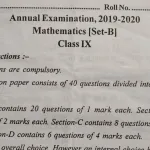A pre-nursery syllabus is designed to introduce young learners to the basics of education in a fun and interactive way. It aims to build their social, emotional, and cognitive skills. The syllabus includes activities that help in developing basic motor skills, language, and creativity.
Advertisements
Briefly Introduce the Exam and its Importance
- The purpose of the exam is to evaluate how well the child has learned the basics of various topics.
- It helps track the progress of early development and gives teachers insights into areas that might need more attention.
- This exam is not to judge performance but to ensure children are comfortable with learning.
Overview of the Exam
- Exam Name and Code: Pre-Nursery Assessment (no specific code).
- Purpose and Goals: To check children’s readiness for school, measuring their learning in areas like language, basic math, and motor skills.
- Intended Audience: Pre-nursery students, typically 3 to 4 years old, and early childhood educators.
Syllabus Structure
- General Layout: The syllabus is organized thematically, covering key developmental areas like language, motor skills, creativity, and social development.
- Breakdown of Units:
- Basic colors and shapes
- Simple numbers and counting
- Introduction to letters and sounds
- Social behavior and sharing
- Basic motor skills (cutting, drawing)
- Organization: Structured around months, with age-appropriate activities for each month.
Exam Format and Structure
- Types of Questions: The exam may involve simple practical tasks, like identifying shapes, colors, or counting objects. Some verbal questions may be included.
- Number of Questions: Around 10-15 simple tasks or questions, designed for the child’s level.
- Time Allocation: The exam should take around 30 minutes.
- Weightage: All sections are of equal importance. Focus is on a child’s interaction with the tasks rather than precise answers.
Assessment Criteria
- Grading: The child’s responses will be evaluated based on how well they perform tasks and engage with the material.
- Key Evaluation Criteria:
- Understanding of basic concepts (colors, shapes, numbers).
- Ability to follow instructions.
- Creativity in tasks.
- Social interaction during group activities.
- Common Pitfalls: Children may be distracted or shy. It’s important to encourage participation without stress.
Sample Questions
Advertisements
- Question 1: Show me a red circle. (Practical task)
- Question 2: What sound does the letter ‘A’ make? (Verbal question)
- Question 3: Count how many blocks are here. (Counting task)
- Solution/Explanation: Each question tests a different skill, from motor skills to language understanding.
Resources and References
- Books:
- “First Steps with Colors and Shapes”
- “ABC’s for Little Learners”
- Online Resources:
- www.kidslearning.com
- YouTube channels like “Preschool Prep Company”
- Articles:
- Early Childhood Education Basics (Available in online journals)
FAQs
- Q1: Do children need to memorize everything for the exam?
- A1: No, the goal is to see if they understand basic concepts.
- Q2: How can parents help their children prepare?
- A2: Practice with fun games, talk about colors, numbers, and letters, and encourage sharing and interaction with other children
Latest Posts
- Step-by-step guide to download and apply for jee mains admit card 202
- Comprehensive 2025 government holidays and recruitment details for job seekers
- JEE Mains Admit Card 2025: Your Step-by-Step Guide to Downloading the Hall Ticket
- Everything You Need to Know About 2025 Government Holidays Recruitment
- Comprehensive Guide to rrb d group recruitment 2025 – Eligibility, Vacancies, and Application
- Detailed guide to nps trust recruitment 2025 vacancies, eligibility and apply process
- Comprehensive guide to hpcl recruitment 2025 notification, vacancies, and application process
- ignou bed admission 2025 complete recruitment guide with eligibility and process
- Comprehensive Guide to Indian Army Agniveer Recruitment 2025 Notification and Jobs
- Everything You Must Know About CBSE Board Exams 2025 Changes & New Rules






